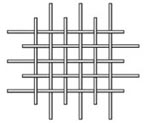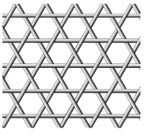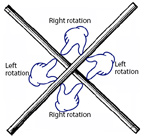Weaving, Mother of Tensegrity
|
About Weaving The ancient invention of weaving reveals in a direct way the basic and universal properties of natural structure such as modularity, left and right helical symmetry, and elementary structural geometry. Two and only two fundamental fabric weave structures exist: the standard two-way plain weave forming squares and the three-way triangle/hexagon weave seen most often in basketry. Though there are many variations such as criss-crossing and doubling, etc., these two are the only primary forms. A single weaving event, passing one thread over another, creates a mini-structure: two filaments crossing and in contact with one another, each warping the other where they press in contact. Bypasses, crosses and Xs have become powerful symbols and signs: a Christian cross, skull and crossbones, crossed fingers, Xd out, sign here, "keep out". When two objects cross one another, two axes are created along the diagonals; one has a right-handed, clockwise helix and the other a left-hand or counterclockwise helix. This, along with magnetism with its north and south polarities, electrons and positrons, is the very root of binariness. This duality which occurs at every crossing teaches the first lesson about the nature of structure. The helical phenomenon plays a vital role in determining how things get connected together. |

Plain Weave

Three-way Weave

A filament crossing
with helical axes identified